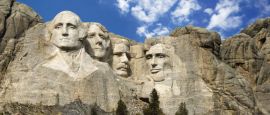United States of America Weather, climate and geography
Weather & climate
Given its vast size and varied geography, the United States experiences a wide range of climates, from tropical to arctic, and just about everything in between. Travellers should always check regional forecasts before visiting, as weather conditions can differ dramatically depending on location and season.
The Northeast (e.g. New York, Boston) has cold, snowy winters and warm, humid summers, while the Southeast (e.g. Florida, Georgia) is more subtropical, with mild winters and hot, humid summers, often with afternoon thunderstorms. Hurricane season affects coastal areas from June to November, particularly along the Gulf Coast and Southeast.
The Midwest (e.g. Chicago, Minneapolis) experiences hot summers and freezing winters, often with snowstorms and cold snaps. The Great Plains can be windy and are known for tornado activity, especially in spring and early summer.
The Southwest (e.g. Arizona, Nevada) is hot and dry, with desert climates and intense summer heat, while the West Coast (e.g. California) offers mild, wet winters and dry, sunny summers, particularly in Southern California.
The Pacific Northwest (e.g. Seattle, Portland) has a temperate marine climate, with wet, cool winters and dry, pleasant summers. In contrast, Alaska features subarctic and arctic conditions, with long, cold winters and short, mild summers. Hawai‘i enjoys a tropical climate year-round, with warm temperatures and two main seasons—dry (April to October) and wet (November to March).
What to pack for a trip to the United States depends heavily on the season and the regions you plan to visit. In general, casual clothing is widely accepted, and comfort is key—jeans, T-shirts, trainers, and light layers are suitable for most everyday situations. However, if you're planning to dine out at upscale restaurants or attend formal events, include at least one smart outfit.
If you're visiting during summer, bring lightweight, breathable fabrics, especially for the humid South or hot deserts of the Southwest.
For winter travel, particularly in the North, Midwest, or mountainous areas, pack warm layers, a heavy coat, gloves, a hat, and waterproof boots. Rain jackets or umbrellas are useful in wetter regions like the Pacific Northwest.
Outdoor and nature enthusiasts should bring appropriate hiking gear, sturdy footwear, and sun protection for national parks and rural areas.
Do you have any Feedback about this page?
© Columbus Travel Media Ltd. All rights reserved. No part of this site may be reproduced without our written permission, click here for information on Columbus Content Solutions.
¿Tiene comentarios sobre esta página?
© Columbus Travel Media Ltd. All rights reserved. Ninguno de los contenidos de esta Web debe ser reproducido sin nuestra autorización expresa y escrita. Para más información sobre como obtener permiso para la utilización del contenido clica aquí. No part of this site may be reproduced without our written permission, click here for information on Columbus Content Solutions .
Avez-vous des commentairessur cette page?
© Columbus Travel Media Ltd. All rights reserved. Le contenu de ce site ne peut être reproduit sans autorisation écrite. Cliquez ici pour plus d'information sur notre 'des solutions de contenu’. No part of this site may be reproduced without our written permission, click here for information on Columbus Content Solutions.
Haben Sie Feedback zu dieser Seite?
© Columbus Travel Media Ltd. All rights reserved. Alle Inhalte dieser Seite sind urheberrechtlich geschützt und dürfen nur mit schriftlicher Genehmigung des Verlags genutzt werden. Weitere Informationen finden Sie in unseren Lizenzbestimmungen. No part of this site may be reproduced without our written permission, click here for information on Columbus Content Solutions .






 You know where
You know where
